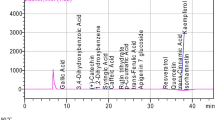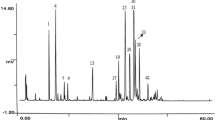Abstract
In this study, the effect of drying temperature on antioxidant activity, phenolic compounds, fatty acid composition and tocopherol content of citrus seeds and oils were studied. Kinnow mandarin seed, dried at 60 °C, exhibited the highest antioxidant activity. Orlendo orange seed had the maximum total phenolic content and α-tocopherol content, with a value of 63.349 mg/100 g and 28.085 mg/g (control samples), respectively. The antioxidant activity of Orlendo orange seed (63.349%) was higher than seeds of Eureka lemon (55.819%) and Kinnow mandarin (28.015%), while the highest total phenolic content was found in seeds of Kinnow mandarin, followed by Orlendo orange and Eureka lemon (113.132). 1.2-Dihydroxybenzene (13.171), kaempferol (10.780), (+)-catechin (9.341) and isorhamnetin (7.592) in mg/100 g were the major phenolic compounds found in Kinnow mandarin. Among the unsaturated fatty acids, linoleic acid was the most abundant acid in all oils, which varied from 44.4% (dried at 80 °C) to 46.1% (dried at 70 °C), from 39.0% (dried at 60 °C) to 40.0% (dried at 70 °C). The total phenolic content, antioxidant activity and phenolic compounds of citrus seeds and tocopherol content of seed oils were significantly affected by drying process and varied depending on the drying temperature.


Similar content being viewed by others
References
Aitzetmüller K (1993) Capillary GLC fatty acid fingerprints of seed lipids—a tool in plant chemotaxonomy. J High Resolut Chrom 16:488–490
AOAC (1990) Official methods of analysis, 15th edn. Association of Official Analytical Chemists, Washington
El-Adawy TA, Rahman EH, El-Bedawy AA, Gafar AM (1999) Properties of some citrus seeds. Part 3. Evaluation as a new source of protein and oil. Nahrung 43:385–391
Garcia-Salas P, Gomez-Caravaca AM, Arraez-Roman D, Segura-Carretero A, Guerra-Hernandez E, Garcia-Villanova B, Fernandez-Gutierrez A (2013) Influence of technological processes on phenolic compounds, organic acids, furanic derivatives, and antioxidant activity of whole-lemon powder. Food Chem 141:869–878
Gültekin Ö, Özcan MM, AlJuhaimi F (2016) Some physicochemical properties, fatty acid composition, and tocopherol contents of Citrus seed oils. Riv Sostanze Grasse 93:47–51
Hosamani KM, Sattigeri RM (2000) Industrial utilization of Rivea ornata seed oil: a moderate source of vernolic acid. Ind Crops Prod 12:93–96
ISO-International Organization for Standardization (1978) Animal and vegetable fats and oils preperation of methyl esters of fatty acids. ISO, Geneve, pp 1–6
Jorge N, da Silva AC, Aranha CPM (2016) Antioxidant activity of oils extracted from orange (Citrus sinensis) seeds. An Acad Bras Ciênc 88(2):951–958
Lee SK, Mbwambo ZH, Chung HS, Luyengi L, Games EJC, Mehta RG (1998) Evaluation of the antioxidant potential of natural products. Comb Chem High Throughput Screen 1:35–46
Malacrida CR, Kimura M, Jorge N (2012) Phytochemicals and antioxidant activity of citrus seed oils. Food Sci Technol Res 18(3):399–404
Marinova EM, Yanishlieva NV (1998) Antioxidative action of quercetin and morin in triacylglycerols of sunflower oil at ambient and high temperatures. Seifen Ole Fette Wachse 124:10–16
Matthaus B, Özcan MM (2012) Chemical evaluation of citrus seeds, an agro-industrial waste, as a new potential source of vegetable oils. Grasas Aceites 63(3):313–320
Molan A, Ismail MH, Nsaif RH (2016) Phenolic contents and antioxidant activity of peels and seeds of orange (Citrus sinensis) cultivated in Iraq. World J Pharm Pharm Sci 5(4):473–482
Moulehi I, Bourgou S, Ourghemmi I, Tounsi MS (2012) Variety and ripening impact on phenolic composition and antioxidant activity of mandarin (Citrus reticulate Blanco) and bitter orange (Citrus aurantium L.) seeds extracts. Ind Crops Prod 39:74–80
Muuse BG, Cuperus FP, Derksen JTP (1992) Composition and physical properties of oils from new oilseed crops. Ind Crops Prod 1:57–65
Püskülcü H, İkiz F (1989) Introduction to statistic. Bilgehan Press, İzmir, p 333 (in Turkish)
Saidani M, Dhifi W, Marzouk B (2004) Lipid evaluation of some Tunisian citrus seeds. J Food Lipids 11:242–250
Spica MJ, Kraljic K, Koprivnjak O, Skevin D, Zanetic M, Katalinic M (2015) Effect of agronomical factors and storage conditions on the tocopherol content of Oblica and Leccino virgin olive oil. J Am Oil Chem Soc 92:1293–1301
Sultana B, Anwar F, Mushtaq M, Alim M (2015) Citrus residues: a potential source of phenolics with high antioxidant values. Int Food Res J 22(3):1163–1168
Yoo KM, Lee KW, Park JB, Lee HJ, Hwang IK (2004) Variation in major antioxidants and total antioxidant activity of Yuzu (Citrus junos Sieb ex Tanaka) during maturation and between cultivars. J Agric Food Chem 52:5907–5913
Acknowledgements
The authors extend their appreciation to the International Scientific Partnership Program ISPP at King Saud University for funding this research work through ISPP# 0015.
Author information
Authors and Affiliations
Corresponding author
Rights and permissions
About this article
Cite this article
Al Juhaimi, F., Özcan, M.M., Uslu, N. et al. The effect of drying temperatures on antioxidant activity, phenolic compounds, fatty acid composition and tocopherol contents in citrus seed and oils. J Food Sci Technol 55, 190–197 (2018). https://doi.org/10.1007/s13197-017-2895-y
Revised:
Accepted:
Published:
Issue Date:
DOI: https://doi.org/10.1007/s13197-017-2895-y




